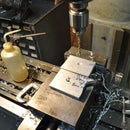Introduction: Quick Change Radius (Ball) Turner for Metal Lathe
I built this radius/ball turner a few years back, and thought I should finally share what I learned. This is actually the second radius turner I made- the first was such a disaster that really settled in to research what other people did, and apply that to my own needs. If I were to build it again today, I would make only minor changes (mostly in the materials/thicknesses used), but generally I am very pleased with its performance and flexibility after several years of intermittent use.
Though I had several photos from the initial build more than three years ago, there were plenty of gaps, so for your sake, I took the tool completely apart (except for the bearings), and re-photographed it. I have also included some of the CAD drawings I managed to save.
All that being said, this particular instructable is not so much to provide a step by step "how-to," but rather the inspiration for your own creation. As I said, were I to do it again, I would build it slightly differently, as I'm sure you will too.
I have access to a fairly complete shop, but perhaps you do not. Feel free to make do with what you have, innovate and experiment. Do not let the limitations of your tools dictate the directions you take.
Tools:
- Portable Bandsaw
- Angle Grinder
- TIG Welder
- CNC Mill
- Vertical Mill
- Lathe
- Arbor Press
Materials:
- 1/2" Steel Plate, Hot and Cold Rolled (mild)
- Steel Round Bar, various sizes
- Misc fasteners
- HSS Blank
- Ball Bearings (2)
- Locknut
Step 1: Design Considerations
I often make multiples of parts, which requires frequent tool changes. Many of the radius turners out there require the removal of the tool post, and aren't repeatable in any way. I designed this particular radius turner to be able to drop in and out of the tool post just like any tool. When combined with a digital read-out (DRO) that has multi-tool functions, you can easily make complex and organic shapes that are accurate to within ±.001".
In addition to the flexibility of quick-change, I also wanted to be able to turn large diameter spheres, and have the option for turning concave coves. This radius turner can turn a ball nearly 4" in diameter, and coves of more than 6" in radius. I have used it for coves much more frequently than spheres.
The first step in this design is measuring your lathe. This particular turner works in a variety of lathes, but is designed specifically for 12" and larger lathes. It can easily be scaled down.
Step 2: Machining the Parts
Using a combination of manual and CNC machining techniques, I machined the parts from mild steel. Mild steel works fine, but chromoly or tool steel would work even better.
Step 3: Machining the Tool Holder
I use a 3/16" HSS cutter, so I can easily regrind to adjust the radius of the tip. To make the square hole in the tool holder, I milled a slot, then milled a cap, and welded the two together.
Step 4: Exploded Diagram
This view shows all the parts of the tool as they look today.
Step 5: The Rotating Mechanism
I used two 1" ID sealed ball bearings for my rotating mechanism. They are press fit into the lower housing, and the shaft of the cutter holder slides through them with a .001" slip fit. A 1" nut keeps everything tight.
If you use this style of setup (the same as in a motorcycle wheel hub), you MUST use a sleeve between the two bearings (not visible). This sleeve prevents the inner races of the bearings from being crushed when you tighten the nut. The length of this sleeve is a critical measurement.
The twin ball bearings have zero play, and being packed with grease have a smooth movement with just the slightest resistance. They are far superb to a bushed setup, especially with aggressive cuts.
Step 6: The Rotating Tool Holder
The rotating toolholder (I'm making all these terms up as I go along) is fitted with three set screws (they must be blunt tipped, not cup point, lest they mar the opposing surface and prevent easy sliding). Were I to do this again, I would mark the rotating tool holder and the vertical holder with graduations; perhaps some sort of micro-adjustment knob as well.
Step 7: Baseplate to Bearing Housing
The baseplate clamps the bearing housing securely with a precision machined groove.
Step 8: Fully Adjustable Handle
Many of the radius turners I've seen have fixed handles. I wanted maximum adaptability; whether turning spheres or coves, or something between centers or in a chuck or a collet holder, I wanted to be ready for all situations. The handle design I came up with doesn't look the most rigid, but it has always worked well. The ability to adjust both the angle and the rotation have gotten me out of a bind every time.
Step 9: Final Assembly
The remainder of the tool is made from 1/2" steel plate, and held together with 1/4-20 socket head cap screws. I would recommend at least 1/2" plate, and would probably go as thick as 3/4" plate.
Step 10: Examples of Usage
These are just a small selection of things I've turned with this tool. Good luck on your own venture, I'd love to see what you come up with.













